Themed collection Polymer Chemistry Recent HOT Articles

Using precision polymer chemistry for plastics traceability and governance
Resolving the anonymity of plastic materials is critical for safeguarding the well-being of our natural environments and human health.

Polym. Chem., 2022,13, 6082-6090
https://doi.org/10.1039/D2PY01180H
Reconsidering terms for mechanisms of polymer growth: the “step-growth” and “chain-growth” dilemma
Terms used for mechanisms of polymer growth are varied and problematic; we detail here our concerns with the terms “step-growth” and “chain-growth.” Ultimately, we seek terms that are simple, accurate, and attractive to the polymer community.
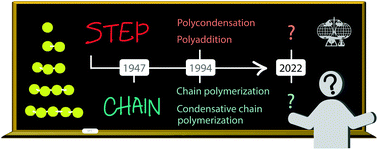
Polym. Chem., 2022,13, 2262-2270
https://doi.org/10.1039/D2PY00086E
Controlled orthogonal reactions in neat polymerizations
In this Minireview, we discuss recent implementations of orthogonal neat polymerization reactions for emerging applications including 3D printing, multimaterials, optical materials, and photo-responsive materials.

Polym. Chem., 2024,15, 3954-3966
https://doi.org/10.1039/D4PY00666F
Chemical design and synthesis of macromolecular profluorescent nitroxide systems as self-reporting probes
The objective of this mini-review article is to highlight the importance of the chemical design towards the synthesis of polymeric profluorescent nitroxides applicable as self-reporting probes.

Polym. Chem., 2022,13, 1648-1657
https://doi.org/10.1039/D1PY01645H
Polyols from cashew nut shell liquid (CNSL): corner-stone building blocks for cutting-edge bio-based additives and polymers
From CNSL to polyols.

Polym. Chem., 2024,15, 4375-4415
https://doi.org/10.1039/D4PY00851K
Radical decarboxylation: an emerging tool in polymer synthesis
Radical decarboxylation has emerged as a powerful tool in polymer chemistry. This review discusses the history of radical decarboxylation and its applications in polymer synthesis, crosslinking, functionalisation, degradation and depolymerisation.

Polym. Chem., 2024,15, 2537-2547
https://doi.org/10.1039/D4PY00267A
Nanoconfined synthesis of conjugated ladder polymers
This review highlights recent advances in controlled synthesis of conjugated ladder polymers using templates.
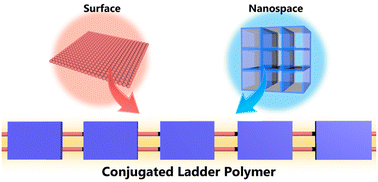
Polym. Chem., 2022,13, 5003-5018
https://doi.org/10.1039/D2PY00809B
Recent advances in the ring-opening polymerization of sulfur-containing monomers
Inspired by the broad range of applications for sulfur-containing polymers, this article presents an overview regarding various ROP technologies (ROP/rROP/ROMP) which cement the importance of sulfur-containing monomers in modern polymer chemistry.

Polym. Chem., 2022,13, 4858-4878
https://doi.org/10.1039/D2PY00831A
Thiolactone chemistry, a versatile platform for macromolecular engineering
This review covers the extensive use of γ-thiolactone chemistry as a versatile and powerful tool for macromolecular engineering and the preparation of various polymer architectures, such as functional, alternating, or sequence-controlled (co)polymers.

Polym. Chem., 2022,13, 4592-4614
https://doi.org/10.1039/D2PY00731B
Reversible complexation mediated polymerization: an emerging type of organocatalytically controlled radical polymerization
Reversible complexation mediated polymerization (RCMP) was developed as a new class of controlled radical polymerization (CRP) using organic catalysts. In particular, photo-RCMP is among the simplest, cheapest, and most robust photoinduced CRPs.
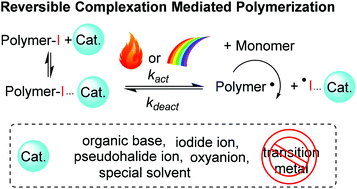
Polym. Chem., 2022,13, 2402-2419
https://doi.org/10.1039/D2PY00120A
From macromonomers to bottlebrush copolymers with sequence control: synthesis, properties, and applications
This review article focuses on recent advances of bottlebrush copolymers prepared by a ring-opening metathesis polymerization, from synthesis efforts to properties and applications.
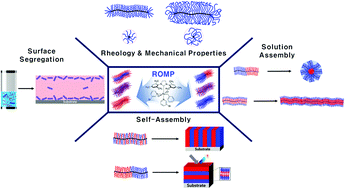
Polym. Chem., 2022,13, 2224-2261
https://doi.org/10.1039/D2PY00126H
Upcycling of BPA-PC into trimethylene carbonate by solvent assisted organocatalysed depolymerisation
This study describes the solvent-assisted organocatalysed depolymerisation of BPA-PC at low temperature for the selective formation of trimethylene carbonate. The key role of 1-methylimidazole as solvent and imidazole as catalyst is investigated.

Polym. Chem., 2023,14, 2299-2307
https://doi.org/10.1039/D3PY00441D
Versatile fully-substituted triazole-functionalized polypeptides with a stable α-helical conformation for gene delivery
A library of polypeptides bearing fully-substituted triazoles (FT) was developed via a Cu-catalyzed multicomponent reaction (MCR), which avoided the undesired hydrogen bonding and stabilized the α-helix in a broad pH range.

Polym. Chem., 2022,13, 5042-5047
https://doi.org/10.1039/D2PY00894G
Tailoring the luminescence of FRET systems built using supramolecular polymeric nanotubes
Supramolecular polymeric nanotubes self-assembled from cyclic peptide–polymer conjugates are employed as general scaffolds to fabricate supramolecular FRET systems with tailorable and responsive luminescence.
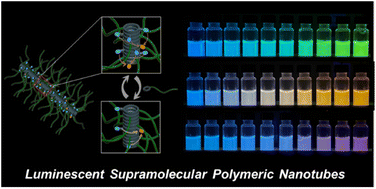
Polym. Chem., 2022,13, 4366-4371
https://doi.org/10.1039/D2PY00557C
Investigation of two-photon polymerized microstructures using fluorescence lifetime measurements
A fluorescent molecular rotor is exploited as a viscosity probe to reveal heterogeneity in multi-material microstructures made by two-photon polymerization. These results open the door to probe the 4D character of active 3D microstructures.
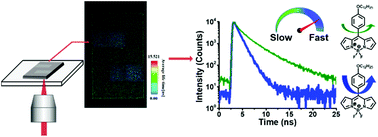
Polym. Chem., 2022,13, 2902-2906
https://doi.org/10.1039/D1PY01728D
3D printed elastomers with Sylgard-184-like mechanical properties and tuneable degradability
Digital light 3D printing of biodegradable elastomers with mechanical properties comparable to the ones of Sylgard-184 via dual-polymer resins.
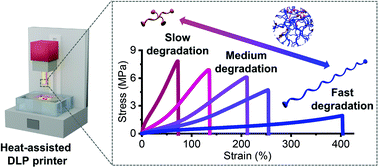
Polym. Chem., 2022,13, 2271-2276
https://doi.org/10.1039/D2PY00113F
High second-order nonlinear optical effect achieved by gradually decreased rotational energy barriers
The second-order nonlinear optical effect was largely enhanced by gradually introducing alkoxy chains, mainly due to the low rotational barriers and moderate isolation effect to facilitate molecular rotations of chromophore moieties.

Polym. Chem., 2025,16, 441-449
https://doi.org/10.1039/D4PY01238K
Increase of spatiotemporal resolution and reproducible layer thicknesses in cationic vat photopolymerization
Pyridines allow a good control of the cationic photopolymerization of epoxies.

Polym. Chem., 2025,16, 126-132
https://doi.org/10.1039/D4PY01046A
Vinylene-linked fully conjugated porous organic polymers based on difluoroboron β-diketonate complexes for green and efficient photocatalysis
Two distinct vinylene-linked fully conjugated POPs were achieved by reacting difluoroboron β-diketonate complexes with reactive methyl groups and a carbazole-bearing aldehyde.

Polym. Chem., 2024,15, 4281-4287
https://doi.org/10.1039/D4PY00947A
Heterogenous catalysis for oxygen tolerant photoredox atom transfer radical polymerization and small-molecule dehalogenation
Heterogeneous photocatalysts (PCs) have garnered attention for their sustainability and cost-effectiveness.

Polym. Chem., 2024,15, 4264-4280
https://doi.org/10.1039/D4PY00899E
Targeting delivery of CRISPR systems into tumours to edit glutamine metabolism for cancer therapy by DPA-Zn-modified nanoparticles
Functional polymer nanoparticles deliver CRISPR-Cas9 into tumours to efficiently and simultaneously cut off two different genes to manipulate glutamine metabolism for fighting cancers.

Polym. Chem., 2024,15, 3736-3750
https://doi.org/10.1039/D4PY00591K
Amine-containing block copolymers for efficient catalyst-free hydroamination and preparation of functional metallopolymers
Cobaltocenium-containing block copolymers were prepared by post-functionalization using a quantitative and block-selective hydroamination reaction. Resulting metallopolymers show micro-phase separated morphology and tuneable surface hydrophilicity.

Polym. Chem., 2024,15, 3519-3528
https://doi.org/10.1039/D4PY00780H
Vat photopolymerization using catalytic chain transfer polymerization (CCTP) derived reactive oligomers to influence mechanical properties
ω-Vinyl terminated reactive oligomers of 2-ethylhexyl methacrylate and poly(ethylene glycol)methacrylate (PEGMA) were synthesized via CCTP and subsequent addition–fragmentation chain transfer (AFCT) polymerization.

Polym. Chem., 2024,15, 2959-2969
https://doi.org/10.1039/D4PY00482E
Ring-opening (co)polymerization of chiral seven-membered lactones mediated by achiral yttrium catalysts: insights into the catalyst stereocontrol by mass spectrometry
The ROCOP of equimolar mixtures of (R)-CLnBu/(S)-CLMe enabled the assessment of the ROP stereocontrol ability of yttrium catalysts through the degree of alternation via detailed mass spectrometric analyses.

Polym. Chem., 2024,15, 1975-1991
https://doi.org/10.1039/D4PY00330F
Directing network degradability using wavelength-selective thiol-acrylate photopolymerization
Thiol-acrylate photoresin containing dynamic disulfide bonds undergoes wavelength-selective photopolymerization under green vs. UV light to produce a degradable step-growth network vs. permanent chain-growth network.

Polym. Chem., 2024,15, 1141-1151
https://doi.org/10.1039/D3PY01285A
cis-Fused cyclohexane promoted the chemical recycling of polycarbonate to monomer
A seven-membered cyclic carbonate bearing a cis-fused cyclohexane structure enabled the chemical recycling of polycarbonate to high-ring-strain monomer.

Polym. Chem., 2024,15, 1070-1076
https://doi.org/10.1039/D4PY00005F
Blocky bromination of poly(ether ketone ketone) as a means to preserve crystallizability and rapid crystallization kinetics
Blocky bromination of PEKK yields superior crystallizability, high %Xc, Tg, Tm, Tc, and faster crystallization kinetics compared to random analogs.

Polym. Chem., 2024,15, 609-621
https://doi.org/10.1039/D3PY01338C
A flexible solid-state electrolyte based on comb-like PEG-functionalized covalent organic frameworks for lithium metal batteries
A composite polymer solid electrolyte was prepared with a fast highway for Li+ conduction based on the robust network of covalent organic framework, which shows good stability and superior electrochemistry performance.

Polym. Chem., 2024,15, 454-464
https://doi.org/10.1039/D3PY01265D
Achieving two-photon fluorescence bioimaging and photodynamic therapy for D–A conjugated polymers through manipulating twisted intramolecular charge transfer
Two-photon fluorescence bioimaging holds immense promise for deep tissue imaging.

Polym. Chem., 2023,14, 5191-5199
https://doi.org/10.1039/D3PY01093G
Molecular engineering of donor–acceptor sp2-carbon-linked covalent organic frameworks for enhancing photocatalytic hydrogen production
Three sp2-carbon-linked D–A COFs have been successfully synthesized via a Knoevenagel condensation reaction. The TTh-COF with strong electron-donating unit of benzotrithiophene exhibits an impressive hydrogen evolution rate 22.22 mmol h−1 g−1.

Polym. Chem., 2023,14, 5133-5139
https://doi.org/10.1039/D3PY01069D
A fast and efficient way of obtaining the average molecular weight of block copolymers via DOSY
Diffusion-ordered NMR spectroscopy (DOSY) allows for excellent determination of block copolymer molecular weights.

Polym. Chem., 2023,14, 5140-5146
https://doi.org/10.1039/D3PY01075A
Exploring effects of polymeric stabiliser molecular weight and concentration on emulsion production via stirred cell membrane emulsification
Polymer stabiliser adsorption kinetics influence a stirred-cell membrane emulsification process output. An optimized combination of low/higher MW PVA at very low concentration (0.1 wt%) produces narrow size distribution and size-controlled droplets.

Polym. Chem., 2023,14, 5049-5059
https://doi.org/10.1039/D3PY00948C
Photo-responsive disassembly of supramolecular polymer bottlebrushes in water
Azo-(U-PEO)2 self-assembled into long supramolecular nanocylinders in water and disassembly was triggered by photo-induced trans → cis isomerization of azobenzene units.

Polym. Chem., 2023,14, 4970-4978
https://doi.org/10.1039/D3PY00963G
Photoredox Diels–Alder ladder polymerization
Ladder polymers with highly saturated backbones are prepared using a photoredox-catalyzed radical cation Diels–Alder polymerization.

Polym. Chem., 2023,14, 4906-4911
https://doi.org/10.1039/D3PY00833A
Ring-opening polymerization of functionalized aliphatic bicyclic carbonates
The development of new functional polycarbonates through ring-opening polymerization (ROP) of cyclic precursors is described.

Polym. Chem., 2023,14, 4748-4753
https://doi.org/10.1039/D3PY00860F
A novel polymer electrolyte with in situ polymerization and a high concentration of lithium salts for lithium metal batteries
A novel polymer electrolyte with high stability and high performance is prepared by in situ polymerization for lithium metal batteries.
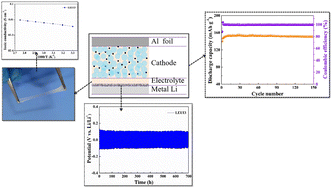
Polym. Chem., 2023,14, 1094-1102
https://doi.org/10.1039/D2PY01208A
An efficient cyclodepolymerization route for the chemical recycling of poly(ethylene adipate)
We present here a green cyclodepolymerization route for the chemical recycling of poly(ethylene adipate) to its cyclic oligomers based on ring–chain equilibria in solution.
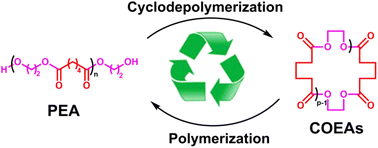
Polym. Chem., 2023,14, 1019-1026
https://doi.org/10.1039/D2PY01613C
Initiating abilities of diphosphine- and diamine-ligated Pd complexes/NaBPh4 systems for C1 polymerization of diazoacetates
(Diamine)Pd(0)(dichlone)/NaBPh4 systems have been revealed to be effective initiators for diazoacetate polymerization, yielding moderately syndiotactic polymers in moderate yields.

Polym. Chem., 2023,14, 1007-1018
https://doi.org/10.1039/D2PY01548J
Model dynamic covalent thermoresponsive amphiphilic polymer co-networks based on acylhydrazone end-linked Tetronic T904 star block copolymers
Hydrogels based on acylhydrazone end-linked Tetronic T904 four-armed amphiphilic star block copolymers show thermally-induced aqueous self-assembly and toughening, and cross-link dissociation and association traceable via simple 1H NMR spectroscopy.
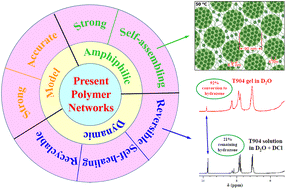
Polym. Chem., 2023,14, 201-211
https://doi.org/10.1039/D2PY01256A
Moisture tolerant cationic RAFT polymerization of vinyl ethers
Cationic RAFT of vinyl ethers was performed without reagent purification and under ambient conditions by utilizing a PCCP acid initiator with a HBD catalyst. Despite inherent nucleophiles, the system retained high chain end fidelity and modularity.
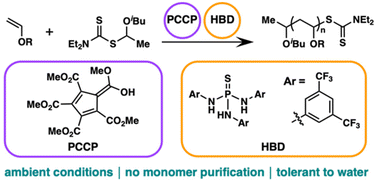
Polym. Chem., 2022,13, 5974-5979
https://doi.org/10.1039/D2PY00780K
Structural analysis of hyperbranched polyhydrocarbon synthesized by electrochemical polymerization
Structure of a hyperbranched polyhydrocarbon obtained by electrochemical polymerization was analyzed by various NMR techniques and modeling. The calculated physical properties from its bulk model system well matched with experimental results.
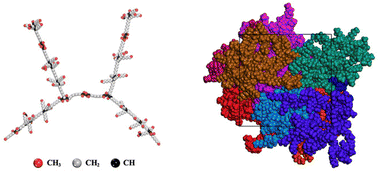
Polym. Chem., 2022,13, 5309-5315
https://doi.org/10.1039/D2PY00756H
Statistical copolymers of thiophene-3-carboxylates and selenophene-3-carboxylates; 77Se NMR as a tool to examine copolymer sequence in selenophene-based conjugated polymers
Here, a new class of ester-functionalized polychalcogenophene is reported, the poly(3-alkylesterselenophene). Moreover, a series of thiophene–selenophene copolymers were prepared.
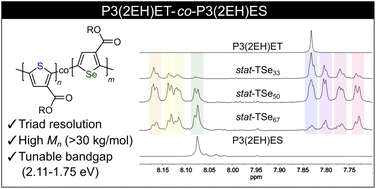
Polym. Chem., 2022,13, 5316-5324
https://doi.org/10.1039/D2PY00777K
Synthesis and characterization of polysulfides formed by the inverse vulcanisation of cyclosiloxanes with sulfur
Polysulfides cross-linked with cyclosiloxanes were synthesized, characterized and tested as solvent sorbents.
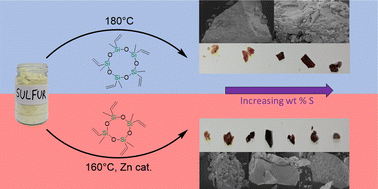
Polym. Chem., 2022,13, 4717-4726
https://doi.org/10.1039/D2PY00581F
Barbier single-atom polymerization induced emission as a one-pot approach towards stimuli-responsive luminescent polymers
A one-pot strategy for the design of stimuli-responsive luminescent polymers has been demonstrated through Barbier PIE, where the N,N-dimethyl moiety endows the polymers with both stimuli-responsive and red-shifted nonconjugated emission properties.
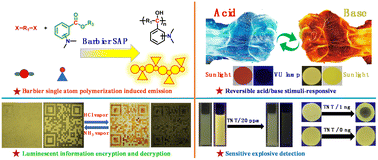
Polym. Chem., 2022,13, 4524-4534
https://doi.org/10.1039/D2PY00816E
Tailoring intermolecular interactions in ion gels with rationally designed phosphonic acid polymers
Design strategies of phosphonic acid polymers established advanced ion gels with high ionic conductivity, mechanical strength, and self-healing ability via a configurable balance of ionic and hydrogen bonding interactions at the molecular level.
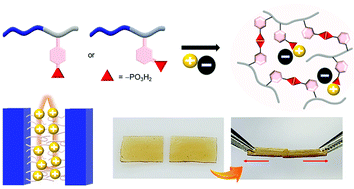
Polym. Chem., 2022,13, 4372-4383
https://doi.org/10.1039/D2PY00646D
A block copolymer templated approach for the preparation of nanoporous polymer structures and cellulose fiber hybrids by ozone treatment
Porous nanostructures were derived after self-assembly of amphiphilic block copolymers and subsequent ozone-mediated block segment degradation. Highly ordered pores were obtained for BCP films and for coatings at cellulose fibers’ surfaces.

Polym. Chem., 2022,13, 4028-4046
https://doi.org/10.1039/D2PY00562J
Donor modification of thermally activated delayed fluorescence photosensitizers for organocatalyzed atom transfer radical polymerization
TADF donor-acceptor conjugates were applied as photosensitizers for organocatalyzed organic atom transfer radical polymerization. A donor-modification strategy was found to dramatically improve the control over the polymerization.
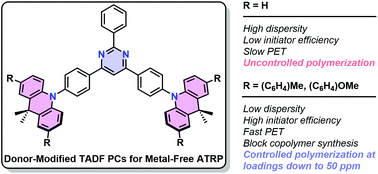
Polym. Chem., 2022,13, 3892-3903
https://doi.org/10.1039/D2PY00470D
Ductile gas barrier poly(ester–amide)s derived from glycolide
Sustainable poly(ester–amide)s derived from glycolide have been synthesized and their thermal, mechanical, and gas barrier properties have been studied by systematically changing the number of methylene groups.

Polym. Chem., 2022,13, 3882-3891
https://doi.org/10.1039/D2PY00479H
Synthesis and derivatization of epoxy-functional sterically-stabilized diblock copolymer spheres in non-polar media: does the spatial location of the epoxy groups matter?
Epoxy-functional sterically-stabilized diblock copolymer nanoparticles are prepared via PISA in mineral oil and then derivatized using various reagents and reaction conditions.

Polym. Chem., 2022,13, 3619-3630
https://doi.org/10.1039/D2PY00559J
Supramolecularly cross-linked nanoassemblies of self-immolative polyurethane from recycled plastic waste: high encapsulation stability and the triggered release of guest molecules
Recycled plastic waste based self-immolative polyurethane has been synthesized and nanoformulated for tumor relevant pH induced charge modulation, efficient guest encapsulation and triggered release in a controlled fashion.
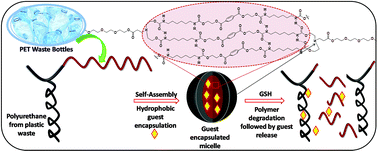
Polym. Chem., 2022,13, 3294-3303
https://doi.org/10.1039/D2PY00341D
Influence of the molecular weight and size distribution of PSS on mixed ionic-electronic transport in PEDOT:PSS
Controlling the dispersity of PSS allows to control the performance of PEDOT:PSS in organic electrochemical transistors (OECTs).
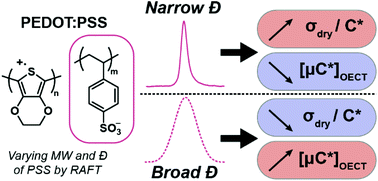
Polym. Chem., 2022,13, 2764-2775
https://doi.org/10.1039/D2PY00271J
Benzothiazole-disulfide based redox-responsive polymers: facile access to reversibly functionalizable polymeric coatings
Redox-responsive polymers and polymeric coatings containing benzothiazole-disulfide groups provide facile access to reversibly functionalizable platforms.

Polym. Chem., 2022,13, 2595-2607
https://doi.org/10.1039/D2PY00133K
Bio-based porphyrins pyropheophorbide a and its Zn-complex as visible-light photosensitizers for free-radical photopolymerization
Two chlorophyll a derivatives, namely pyropheophorbide a and its corresponding zinc(II) complex, are used as visible-light photosensitizers for free-radical photopolymerization.
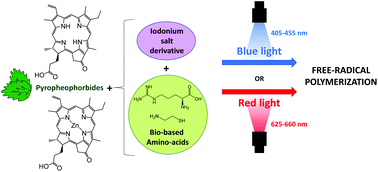
Polym. Chem., 2022,13, 1658-1671
https://doi.org/10.1039/D1PY01714D
The role of transesterifications in reversible polycondensations and a reinvestigation of the Jacobson–Beckmann–Stockmayer experiments
Strong protic acids catalyze intermolecular transesterification in reversible polyester syntheses even at low temperatures (109 °C), an important aspect not considered in the original Jacobson–Stockmayer theory of reversible polycondensations.
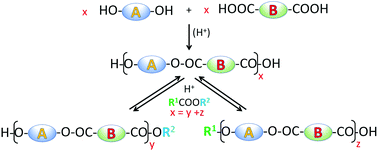
Polym. Chem., 2022,13, 1177-1185
https://doi.org/10.1039/D1PY01679B
About this collection
Welcome to our online rolling collection of the hottest work published in Polymer Chemistry. Here we feature recent Polymer Chemistry articles highlighted as HOT by the handling editor or our referees.
Congratulations to all the authors whose articles are featured.